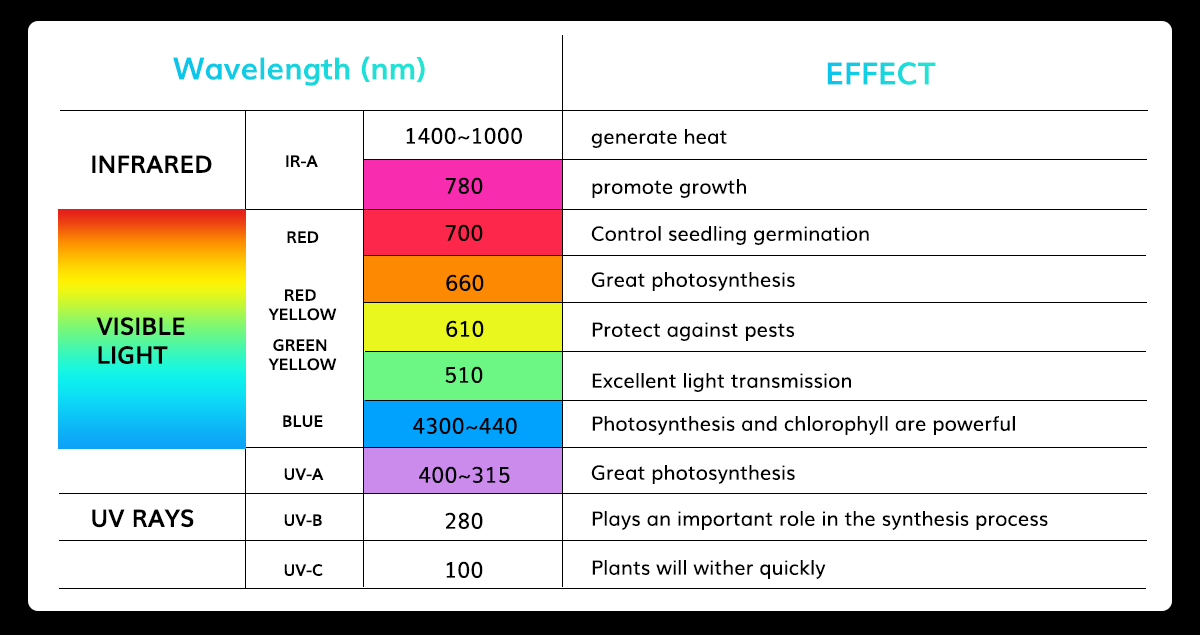When discussing plant growth, the light spectrum is a key concept that cannot be overlooked. Each beam of light consists of wavelengths that together make up what we know as the spectrum. This spectrum includes not only the visible colors from red to violet but also ultraviolet and infrared light, which are invisible to the human eye.
Plants' needs for light go far beyond simple changes in brightness. In fact, different wavelengths affect various physiological processes in plants, from the molecular to the organ level. The spectrum can be divided into several main parts: infrared, visible light, and ultraviolet.
Effects of Different Spectral Regions on Plants

Red Light (620-750 nm):
Red light is crucial for plant growth. It plays a dominant role in photosynthesis, affecting leaf expansion and plant height. Approximately 90% of red light is absorbed by plant leaves, significantly influencing growth and development.
However, using red light alone may not be sufficient for optimal plant growth as it tends to promote height over volume.
Blue Light (450-495 nm):
Blue light is essential for normal plant growth. It helps inhibit excessive stem elongation and stimulates the production of chlorophyll and proteins.
Blue light also contributes to thicker leaves and sturdier stems, which are crucial for healthy plant development. While beneficial, excessive blue light can inhibit plant growth.
Green Light (495-570 nm):
Although green light's direct effect on plants is less pronounced than blue or red light, it plays a significant role in enhancing photosynthetic depth in plant leaves.
Green light can penetrate deeper into the foliage, aiding photosynthesis in lower leaves and thus improving the plant's overall energy efficiency.
Yellow Light (570-590 nm) and Orange Light (590-620 nm):
Yellow and orange light contribute to photosynthesis, though less so than red and blue light. Adding yellow light to a combination of red and blue can significantly enhance the growth of certain crops, such as spinach seedlings.
Ultraviolet Light:
UV-A (320-400 nm): Stimulates plant growth and enhances pigment synthesis, such as anthocyanins, increases crop yield, and promotes the synthesis of proteins, sugars, and organic acids.
UV-B (280-320 nm): Regulates growth by preventing over-extension and has disinfectant properties that help reduce plant diseases. However, excessive UV-B can stunt plants and reduce leaf area.
UV-C (100-280 nm): Highly germicidal, thus often used in agriculture for seed disinfection or disease prevention. UV-C is mostly absorbed by the atmosphere and is rarely found in natural light conditions due to its destructive impact on cells.
Far Red Light (700-800 nm):
Far-red light enhances photosynthesis and metabolism. Research shows that moderate amounts of far-red light can improve the efficiency of photosynthesis in leaves, accelerate nutrient absorption and utilization, and help plants grow faster and develop better.
In agricultural production, adjusting the proportion of far-red light can precisely control the flowering cycles of plants.
Through this explanation, you should have a general understanding of how different light spectra can aid plant growth. Whether you are new to home gardening or a seasoned enthusiast, choosing the right grow light is crucial!
VANQ has 20 years of professional experience in the field of LED grow lights and has successfully served more than 3,000 customers. Click the dialog box below to contact us now. We will provide you with personalized planting solutions based on your planting needs. The first 30 people will receive a 10% discount coupon.























